Muzaffarabad – Chehlum
March 21, 2006

It’s real blade
The mourning of the death of the Prophet’s grandson, Hazrat Hussain, who was killed in a war in Qarbala, 1400 years ago, still continued until the fortieth day after Ashura. It was 20 Safar, 40 days after 10 Muharram, the final day of all of the mourning.
I had experienced the Ashura celebration in Lahore, which was an astonished experience. For Chehlum, I had it in Muzaffarabad. I came quite early in the morning, 12 noon, to the Shia mosque near the chowk of Medina Market. The mosque itself was not big, signified by the black huge flag, distinctive of Shia mosques. An attendant there said that before the earthquake, the mosque was always crowded during this time of the year. But now, many of the believers had gone. Indeed, the majlis was not crowded, the people who came was only about a quarter of the number the space can handle. The majlis speech, delivered in language more about the same as Urdu, also brought the listeners to hysteria.
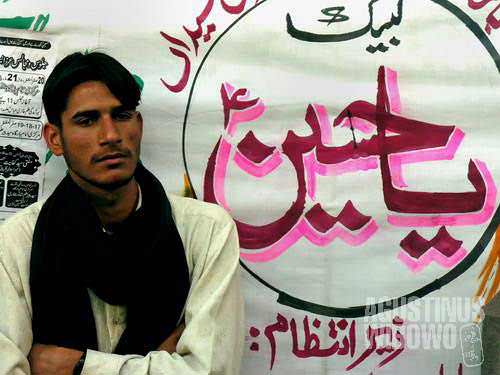
Ya Hussain
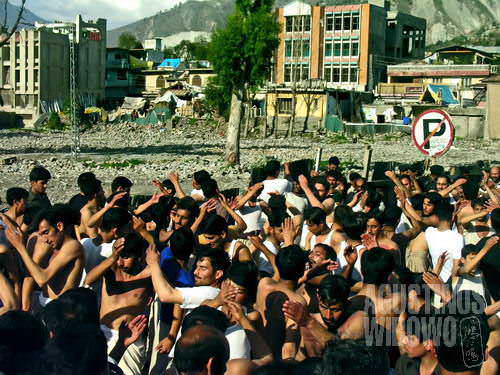
e The mourning parade in earthquake zone
I was escorted by Hamdani, claimed himself as a policeman, to go around the mosque while the majlis speech was delivered. As a common understanding, that most Indonesians were Muslims, the questions given to me, as expected, was always, “Are you Muslim?” I said, “Not yet.” He was happy. The other people were also happy with the answer. Many of them said, “Ho jaega, ho jaega, Inshallah (going to be, going to be, God Willing)”. Hamdani even gave me a Muslim name, “Muhammad Ali”, a combination of the two greatest and respected names in Islam.
During the lunchtime (the lunch was given free to all of visitors), many people came to me, as I was the only obvious foreigners (I didn’t see any others though). Some of them had been working in Saudi Arabia before and had had Indonesian friends. They said that Indonesians were cute and tiny, and also loveable. That’s all. Many concepts, I say ‘mythos’, about Indonesians that Pakistanis usually had. Many people, and today was not the first time, asked me whether it was true that Indonesians were not going to have marriage before doing the pilgrimage to Mecca. I said no. A man, from the Muzaffarabad, explained to me that Shia is well received in Pakistan. He described that the main regions ranged from Manshera up to Nagar, from Daimyor, Astor, until Kashmir. Another guy claimed that 50% of Pakistanis were Shia. I doubted. But he was very confident.

Binding up the holy flags
Hamdani brought me to a mazhar (graveyard) backside of the mosque. He introduced me to ‘his brother’ (he used the word ‘brother’ for all Muslim brothers, I was surprised at the first time that he had introduced more than a dozen of ‘brothers’ to me) who was injured due to the earthquake. This brother lost one of the legs. And walked with two sticks. He was happy to hear the Muslim name that Hamdani gave me.
After the lunch, more and more visitors came to the mosque. There were many signs and posters around the mosques, written in Urdu, “Ya Hussain”, “Live like Hussain and DIE like Hussain”, etc. The concept in Shia in this festival, that the people should also felt the feeling of Hussain when he was killed in the war against cruelty in Qarbala. And in this festival, the pain was more about physical pain. The kalimah shahadat for Muslims included “There is no God but Allah(la illahailallah)” and “Muhammad is the Prophet of Allah(Muhammad ur Rasulullah)”, the Shiah added, “Ali is the Friend of Allah, the direct Successor of the Prophet (Ali un Valiullah, Vazirullah Rasulullah)”. Shia has more compassion and love about Hazrat Ali, the Prophet’s cousin and son-in-low, as the most beloved one. Due to this compassion, Shia followers were called as “Aliwallah”, the people of Ali. They expected Ali to be the successor of the Prophet Muhammad, but, as they believed, Ali was cheated by the so-called Caliphs (Khalifah), and at last became the fourth Caliph. And moreover, Hazrat Ali became the Caliph not more than five years, poisoned to death. Hussain, who was remembered in this ceremony, was the son of Ali, the respected one. Ali was the first Imam for the Shia; they didn’t recognize the Caliphs. Hussain was the third Imam. The Shias believed in twelve Imams, eleven of them has came already, and now they were waiting for the Twelfth Imam, Imam Mahdi, who would come at the end of the world. The black flag of Shia, a guy told me, was flag of Islam. It was flag of Islam, flag of Allah, flag of the Prophet, flag of Ali, flag of Hussain, and also flag of the troop in the Qarbala war. On the roof of the every house of Shia believers, the very same flag was also waved.
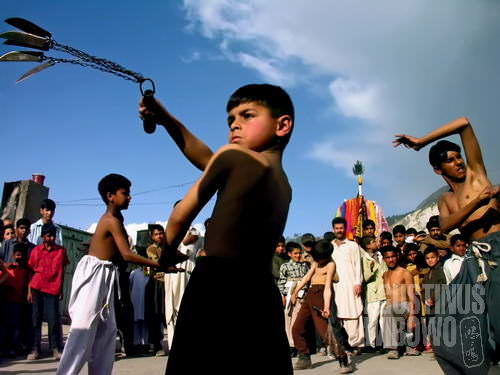
Without fear
At three o’clock, the parade started. Now I was escorted by another man, an old bearded man, dressed in bureaucratic Pakistani style, who claimed as the coordinator of the festival. He arranged for me many places to take the shoot from different angles that I can capture the whole feeling of the celebration, included climbing the walls of the mosque. The parade, is a self-torturing parade. It was started inside the mosque. People stood in lines, beating their own chests, following the rhythm of the chanting from a group of singers. The chanting was about the suffering of Hussain in the war, where the word “Jang e Qarbala” (the war of Qarbala) was shouted for many times, in a emotional and melancholic rhyme.
Then coming the flags. In Ashura the flags were only black. In Chehlum, it was more colorful. In Ashura, people struggled to touch the white horse. In Chehlum, people struggled to touch the colorful flag. Then the flag was taken out. The flag was brought by a little boy, 11 years old, whom I spoke to earlier the day. He spoke very fluent English and had quite European apperance. The flag led the whole parade. The people also went out the mosque. They were divided into three big groups; each contained several dozens of men and boys, standing in lines, face to face, and following the chants of the singers (each group of singers for each group of the men), beating their chest in harmonious way. The beating was so hard, that it became the music of the chanting. Many of the men were half naked, and the chests were red of the beating, some even had bleeding. This kind of self beating is called as ‘maatam’.
The parade of the people beating themselves moved slowly from the mosque to the main street. Many people watched the ‘maatam’ procession. People not in line also did the ‘maatam’ but in the tender way. The parade moved about five meters, stopped, and the ‘maatam’ was done for five minutes, then moved forward again. The final destination was the chowk of Medina market. The procession was done back grounded by the rubbles of buildings demolished by the earthquake.
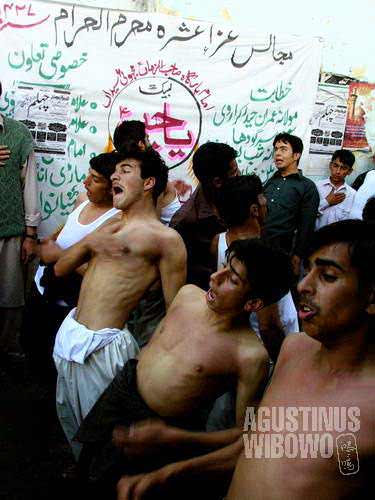
Maatam
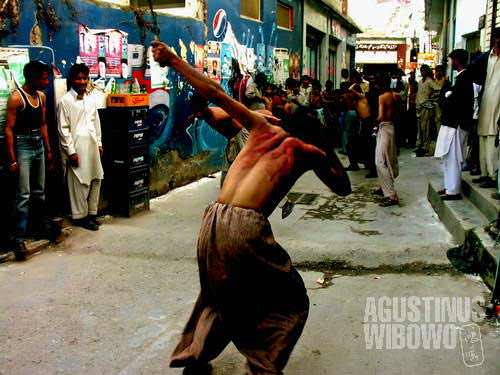
Zaanjirzani
The ‘zanjirzani’, self torturing with chain of knives, were also done. In this time, mostly by young boys and children. The knives for the children are much smaller than the ones used by the adults. But they also got bleeding on their back. Some young boys, mostly not more than 14 years old, struggled to get the knives. Some even got hysteria and smashing the knives hysterically to the back. The blood was everywhere.
The whole parade moved slowly back to the mosque. With same speed, less energetic ‘maatam’ (people were tired anyway), but more harsh ‘zanjirzani’. The whole procession from the mosque until the chowk and back to the mosque took time of 3 hours. Full of beating and bleeding. Children got more hysteric when beating the sharp knives to their back when the others yelled “Imam Hussain…. Hussain mullah, Hussain Mullah…!” On the ground of the mosque, the zanjirzani continued until dawn. More older men also joined the scene. Some men even not only beating the back with the knives, but also beating the head.

Blood everywhere
Blood everywhere.
Mourning period was finished. Forty days was the number.
But Hussain was only the third among eleven Imams whose death to be remembered. A week later, the mourning period for Imam Hassan, the other Imam, would start.
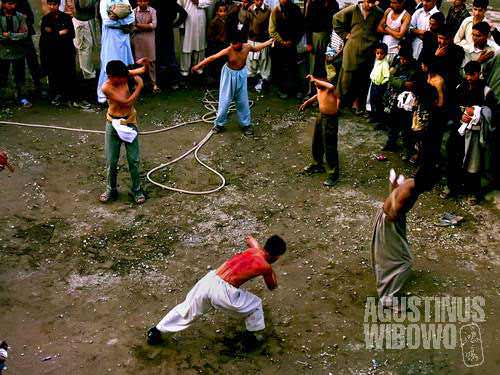
Until late afternoon


ga ngerti gw.. ingris sih heheh
MashAALLAH Molla Husain k chane Walo ko Salamat Rakhe Hamesha Naraiiiiiiiiiiiiiiiiiiiiiiiiiiiiiiiiiiiiiiiiiiiiiiiiiiiiiiiiiiiiiiiiiiiiiiiiiiiiiiiiiiiiiiiiiiiii Heydre
Yaa aaaaaaaaaaaaaaaaaaaaaaaaaaaaaaaaaaaaaaaaaaaaaaaaaaaaaaaaaaaaaaaaaaaaaaaaaaaaaaaaaaaaaaaaaaaaaaALI MADADD Haq Haiderrrrrrrrrrrrrrrrrrrrrrrrrrrrrrrrrrrrrrrrrrrrrrrrrrrrrr